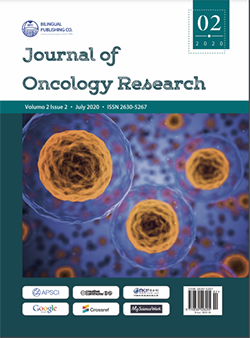CDC20, TOP2A and NEK2 Expression in Esophageal Squamous Cell Carcinoma and Its Clinical Significance
DOI:
https://doi.org/10.30564/jor.v2i2.2549Abstract
Objective: to study the expression and clinical significance CDC20,TOP2A, NEK2 esophageal squamous cell carcinoma. Methods: Toselect 70 patients with esophageal squamous cell carcinoma, Between August 2018 - August 2020, All intraoperative pathological specimens,A group -35 cases), Cancer tissue, B group, adjacent tissues), two groups of CDC20, TOP2A, NEK 2 expression were detected and analyzed by immunohistochemistry and semi-quantitative reverse transcription polymerase chain reaction -RT-PcR) assay.Results: the values of CDC20,TOP2A, NEK2 expression level in A group were significantly higher thanthose in B group -P<0.05). The expression level CDC20, TOP2A, NEK2esophageal squamous cell carcinoma was positively correlated with TNMstage and lymphatic metastasis, and negatively correlated with tumordifferentiation. Conclusion: CDC20, TOP2A, NEK2 high expression leveldirectly affects the metastasis, recurrence and prognosis of esophagealsquamous cell carcinoma. The combination of three indexes can accuratelyevaluate the pathological status of patients with esophageal squamous cellcarcinoma and help to judge the prognosis of patients accuratelyKeywords:
Esophageal squamous cell carcinoma; CDC20; TOP2A; NEK2; Clinical significanceReferences
[1] Xiangyang Le, Mengni Yun, Qianbin Li, et al. Progress in the cdc20 of new tumor therapeutic targets[J]. Journal of Pharmacy, 2017, 52(9): 1366-1371.
[2] Yanli Guo, Xiaoliang Liang, Gang Kuang, et al. Screening and validation of key hub genes in esophageal squamous cell carcinoma based on bioinformatics analysis[J]. Chinese Journal of Cancer Biotherapy, 2019, 26(2): 166-172.
[3] Dongsheng Niu. Expression of CDC20, TOP2A, NEK2 in esophageal squamous cell carcinoma and its correlation with I clinicopathological features and prognosis. Journal of Applied Cancer, 10(33): 1579-1581.
[4] Guifang Zhang, Lingxin Meng, Zhaojun Ding. Advances in molecular targeted therapy of esophageal cancer[J]. Chinese Journal of Physicians, 2015(z2): 226-229.
Downloads
How to Cite
Issue
Article Type
License
Copyright and Licensing
The authors shall retain the copyright of their work but allow the Publisher to publish, copy, distribute, and convey the work.
Journal of Oncology Research publishes accepted manuscripts under Creative Commons Attribution-NonCommercial 4.0 International License (CC BY-NC 4.0). Authors who submit their papers for publication by Journal of Oncology Research agree to have the CC BY-NC 4.0 license applied to their work, and that anyone is allowed to reuse the article or part of it free of charge for non-commercial use. As long as you follow the license terms and original source is properly cited, anyone may copy, redistribute the material in any medium or format, remix, transform, and build upon the material.
License Policy for Reuse of Third-Party Materials
If a manuscript submitted to the journal contains the materials which are held in copyright by a third-party, authors are responsible for obtaining permissions from the copyright holder to reuse or republish any previously published figures, illustrations, charts, tables, photographs, and text excerpts, etc. When submitting a manuscript, official written proof of permission must be provided and clearly stated in the cover letter.
The editorial office of the journal has the right to reject/retract articles that reuse third-party materials without permission.
Journal Policies on Data Sharing
We encourage authors to share articles published in our journal to other data platforms, but only if it is noted that it has been published in this journal.




 Aims and Scope
Aims and Scope Yanjiao Liu
Yanjiao Liu

